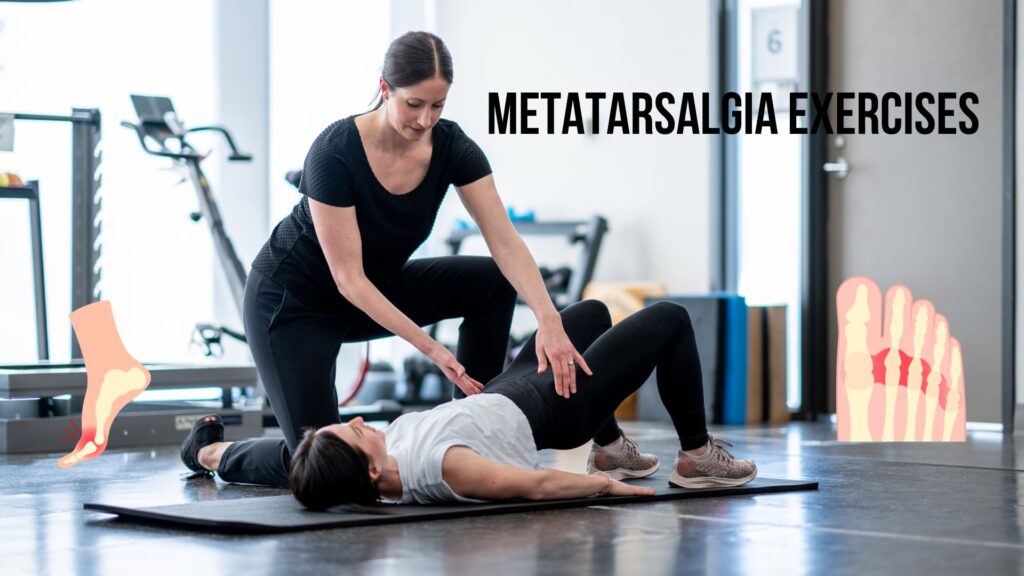Are you experiencing pain in the ball of your foot? Metatarsalgia exercises may be the solution you’re looking for to alleviate this discomfort. By improving foot flexibility and strengthening the muscles of the foot and lower leg, these exercises can help reduce metatarsalgia pain and improve your overall foot health.
Understanding Metatarsalgia and Its Causes
Metatarsalgia is characterized by discomfort and inflammation in the ball of the foot. This condition, often manifesting as a range from mild ache to intense, sharp pain, can severely impact daily activities, making it a challenge to walk or engage in prolonged standing. Various factors contribute to the development of metatarsal discomfort. One of the primary culprits is overuse, particularly in activities that involve repetitive impact on the foot, such as running or jumping. Improper footwear that lacks adequate support or fails to distribute weight evenly across the foot can also lead to or exacerbate this condition. Additionally, individuals with high arches face a higher risk as the structure of their feet places extra stress on the ball of the foot. Similarly, tight calf muscles can pull on the heel, altering foot mechanics and increasing pressure on the metatarsals. Addressing these underlying causes is crucial for managing metatarsalgia effectively. By understanding the specific contributors to this condition, individuals can make informed decisions about treatment and prevention, such as selecting appropriate footwear, modifying physical activities, and incorporating specific exercises and stretches designed to alleviate metatarsalgia symptoms.
The Importance of Foot Flexibility and Muscle Strength
Ensuring that the foot and lower leg muscles are both flexible and strong is a key component in the battle against metatarsalgia. Weak or stiff muscles in these areas can lead to misalignment and undue stress on the ball of the foot, exacerbating pain and discomfort. By focusing on enhancing flexibility, the foot can achieve a better range of motion, which helps in distributing weight more evenly during movement. This reduces the likelihood of placing excessive pressure on any single part of the foot. Simultaneously, strengthening the muscles supports the foot’s arch and improves overall stability, further mitigating the risk of metatarsalgia. Engaging in targeted exercises can dramatically decrease the strain exerted on the metatarsal bones and surrounding tissues, offering a buffer against the impact of daily activities. It’s not just about managing symptoms but fundamentally improving the foot’s biomechanics through a dedicated regimen of stretching and strengthening routines. Such practices not only address the immediate concerns related to metatarsalgia but also contribute to the long-term health and functionality of the feet. By prioritizing these aspects of foot care, individuals can make significant strides toward overcoming discomfort and enhancing their quality of life.
Preparing Your Feet for Exercise
Before embarking on the journey to relieve metatarsalgia through targeted exercises, it’s crucial to set the stage for an effective workout. This starts with a thorough warm-up of your feet to promote flexibility and reduce the risk of injury. One beneficial way to do this is through a gentle yet comprehensive massage of the entire foot, focusing on the soles and extending to the toes and heel. This can help stimulate blood circulation and relax the muscles, preparing them for the stretches and exercises ahead.
Another effective method to prep your feet involves the use of a tennis ball or a frozen water bottle. By gently rolling your foot over these objects, you can achieve a deeper massage, targeting areas that may be harder to reach with your hands alone. This technique is particularly useful for loosening up tight muscles and easing any pre-existing tension in the foot, setting a perfect baseline for engaging in exercises designed to combat metatarsalgia pain.
It’s important to approach this pre-exercise routine with care and attention, ensuring that each movement feels comfortable and beneficial. Taking the time to properly warm up and prepare your feet not only enhances the effectiveness of the exercises to follow but also contributes to a holistic approach to foot health and pain management.
Top Exercises to Alleviate Metatarsalgia Pain
To combat metatarsalgia pain effectively, incorporating a variety of exercises aimed at strengthening and flexing the foot and lower leg muscles is key. One beneficial exercise is toe curls, which involves laying a towel flat on the floor, then using your toes to gather and pull the towel towards you. This simple yet effective movement helps build strength in the foot’s muscles.
Marble pickups offer another excellent exercise option. By placing a few marbles on the ground and using your toes to pick them up and place them in a cup, you not only enhance the dexterity of your toes but also improve the muscular support around the metatarsals.
Calf raises are crucial for strengthening the lower leg and supporting the overall structure of the foot. Standing flat-footed, slowly rise onto your tiptoes, hold the position briefly, then gently lower back down. This exercise targets the calf muscles, reducing the strain transferred to the ball of the foot.
Ankle circles further contribute to foot flexibility and strength. Seated with your feet off the ground, rotate your foot at the ankle in a circular motion. Alternate between clockwise and counter-clockwise directions to ensure a full range of motion. This activity helps loosen tight muscles and improves circulation, aiding in the reduction of metatarsalgia symptoms.
Incorporating these exercises into your daily routine can play a pivotal role in alleviating the discomfort associated with metatarsalgia, offering a pathway to enhanced foot health and mobility without relying on repetitive information or concluding remarks.
Stretches to Enhance Foot Flexibility
Stretching plays a pivotal role in combating metatarsalgia by enhancing foot and ankle flexibility. Initiating your stretch routine with calf stretches can greatly benefit the overall alignment and relieve pressure on the ball of the foot. To perform a calf stretch, stand an arm’s length from a wall, step one foot back, and keep it straight while bending the front knee slightly. Hold this position, feeling a stretch in the back leg’s calf muscle.
Another valuable stretch targets the toes, improving their flexibility and strength. Sit with your legs extended forward and gently pull your toes back towards you until you feel a stretch along the bottom of your foot and into your Achilles tendon.
The plantar fascia stretch is specifically designed to alleviate tension in the arch and ball of the foot. Seated, cross one leg over the other and pull the toes of the crossed foot back towards your shin. This stretch should be felt along the bottom of your foot, extending into the heel.
Incorporating these stretches into your daily routine, particularly before and after engaging in activities or exercises, can significantly aid in preventing and managing metatarsalgia.
Must Read: Transform Your Lats: The 8 Best Dumbbell Exercises
Incorporating Daily Habits to Support Foot Health
Adopting a lifestyle that promotes foot health is crucial in the prevention and management of metatarsalgia. An essential daily habit is selecting footwear that provides proper support, especially shoes with a cushioned sole and adequate room for the toes to move freely. This choice helps distribute body weight evenly, reducing stress on the metatarsals. Equally important is maintaining a healthy body weight, as excess weight can increase pressure on the feet, exacerbating pain in the ball of the foot. Integrating low-impact exercises such as swimming or cycling into your fitness routine can also contribute to foot health by minimizing direct impact on your feet while still promoting cardiovascular health and muscle strength. Additionally, take breaks to elevate your feet if your day involves prolonged periods of standing or walking, as this can help reduce swelling and relieve pressure on the ball of the foot. Regularly practicing foot relaxation techniques, such as soaking your feet in warm water or engaging in gentle foot massages, can further aid in preventing tightness and discomfort in the foot. By incorporating these habits into your daily life, you actively support the well-being of your feet, helping to ward off metatarsalgia and maintain mobility and comfort.
Monitoring Your Progress and When to Seek Professional Help
As you integrate metatarsalgia exercises into your daily life, keeping an eye on how your body responds is key. Notice any changes in pain levels or discomfort that might arise as a result of the new regimen. While some initial soreness can be normal, a persistent increase in pain is a clear indication that your body is signaling for a change. It could mean that certain exercises are not suitable for your condition, or perhaps the intensity is too high. In such cases, it’s wise to reassess your approach. Consulting with a healthcare professional such as a podiatrist or physical therapist can be immensely beneficial. They have the expertise to tailor an exercise program specifically to your needs, ensuring that the exercises support healing rather than exacerbate the issue. Remember, the goal of these exercises is to bring relief and improve function, so if the opposite occurs, seeking advice from a professional is the best course of action. Their guidance can be instrumental in helping you navigate your recovery journey, making adjustments as needed to optimize your progress and get you back to feeling your best.



